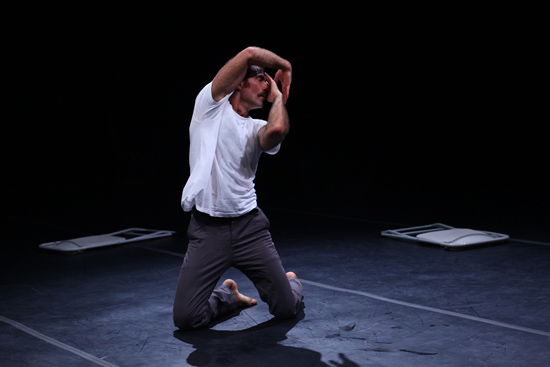
Take it or leave it: “Tool is Loot”
One of the casualties of Tigertail‘s (a Knight Arts grantee) “Tool is Loot” is that it didn’t connect with the audience. At times interesting and bizarre, funny and absurd, emotional yet dry, the performance poses a vexing question for even the most patient viewer: what’s the point?
Throughout a period of one year, choreographers and dancers Wally Cardona and Jennifer Lacey worked with non-dance professionals — an astrophysicist, an architect, a medical supply salesman, an art critic and other “outsiders”— and created movements with these experts for “Tool is Loot.”
The performance began with Lacey, a folding chair, a black curtain backdrop and nothing else. A duet ensued between Lacey and the folding chair. Lacey moved like a gorgeous marionette, her limbs pulled by strings controlled by the commands of a calm male voice coming from the dark. The chair was both support and partner. In fact, the folding chair became a pivotal character/partner for both Lacey and Cardona throughout the performance.
Lacey exited. Cardona entered. He moved across the open space at times like an innocent schoolgirl running through time and space as if the whole world were under his control. Cardona gestured wildly. His face and body energized the space. He drew the audience in. They flew with him. At other times, Cardona’s movements reminded me of Jack Nicholson’s portrayal of the deranged R.P. McMurphy in “One Flew Over the Cuckoo’s Nest.” Odd. Peculiar. Unsettling. Then there was an expected sexual encounter with the folding chair, which was funny, but cliché, yet everyone laughed.
The most interesting segments of the performance took place at the mid-point. Lacey had a conversation with the folding chair, which reminded me of conversations I’ve had with “real” humans. The chair seemed to care about Lacey’s ideas, not her emotions. “There’s something Scandinavian about you,” Lacey says to the folding chair and insulted his ego. Lacey slithered backstage and Cardona reappeared and performed to a poem read aloud by a high-pitched male (or female?) voice. The reading was so exaggerated I couldn’t help but laugh. Ironically, this was the most emotionally moving segment of the performance.
The performance continued and I begin to see the process emerge or merge with what was going on on stage. Their work with professionals, everyday “humans,” mirrored and mapped the mundane, cathartic/anti-cathartic lives we live. Cardona and Lacey worked separately, in the U.S. and France, which was visible in the disconnected, disjointed narrative. I notice the man next to me reading my notes throughout the performance. He was looking for the story where there was none.
As I left the Colony Theatre, a visibly outraged woman approached me and asked, “What was the point?” “You tell me,” I told her. “There was no story,” she said. “Nothing to follow. There was no point.”
The point: “Tool is Loot” is (or was) about the process of creation, not the outcome, and sometimes it’s difficult for an audience to see (or even care about) the process, the nuts and bolts, sweat and tendonitis, that goes into making a performance. It points out the paradox of the human body and brain, which are both flexible and rigid when change and challenge confront us.
Sometimes the audience sees the process emerge during the course of a performance. And sometimes they don’t — no matter how hard they pry.
Recent Content
-
Artsarticle ·
-
Artsarticle ·
-
Artsarticle ·

